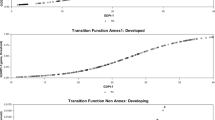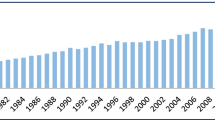Abstract
This work uses parametric and semiparametric panel data analysis methodologies to test the hypothesis of the environmental Kuznets curve, in 186 countries in the period 1960–2019. The main results reveal the acceptance of this hypothesis in the relationships of CO2 emissions (kt) and economic growth (GDP) and urbanization (% population) in the parametric models. Using semiparametric methods, the polynomial relations of fourth degree between CO2 emissions and GDP and of third degree between it and urbanization are verified. The economic policy implications derived from these results seem to indicate the need to continue making efforts in the reduction of CO2 emissions, through greater efforts in innovation and research and development, in search of clean and less polluting energies. The relationship between CO2 and economic growth is a major challenge, in terms of achieving a flattening of this relationship.





Similar content being viewed by others
References
Akinlo AE (2008) Energy consumption and economic growth: evidence from 11 sub-Sahara African countries. Energy Economic 30:2391–2400
Al-Mulali U, Saboori B, Ozturk I (2015) Investigating the environmental Kuznets curve hypothesis in Vietnam. Energy Policy 76:123–131
Anwar A, Younis M, Ullah I (2020) Impact of urbanization and economic growth on CO2 emission: a case of Far East Asian countries. Int J Environ Res Public Health 17:1–8
Apergis N, Payne JE (2014) Renewable energy, output, CO2 emissions, and fossil fuel prices in Central America: Evidence from nonlinear panel smooth transition vector error correction model. Energy Economics. 42:226–232
Apergis N, Payne JE, Menyah K, Wolde-Rufael Y (2010) On the causal dynamics between emissions, nuclear energy, renewable energy, and economic growth. Ecol Econ 69:2255–2260
Baek J (2015) Environmental Kuznets curve for CO2 emissions: the case of Arctic countries. Energy Econ 50:13–17
Bekhet HA, Othman NS (2017) Impact of urbanization growth on Malaysia CO2 emissions: evidence from the dynamic relationship. 154:374–388
Brida JG, Sánchez Cabrera EJ, Segarra V (2020) Clustering and regime dynamics for economic growth and income inequality. Struct Chang Econ Dyn 52:99–108
Cardoso Marques A, Fuinhas JA, Leal PA (2018) The impact of economic growth on CO2 emissions in Australia: the environmental Kuznets curve and the decoupling index. Environ Sci Pollut Res 25:27283–27296
Danish ZB, Wang B, Wang Z (2017) Role of renewable energy and non-renewable energy consumption on EKC: evidence from Pakistan. J Clean Prod 156:855–864
Day KM, Grafton RQ (2003) Growth and the environment in Canada: an empirical analysis. Canadian Journal of Agricultural Economics/Revue Canadienne d’Agroeconomie 51(2):197–216
Delgado MA, Robinson PM (1992) Nonparametric and semiparametric methods for economics research. In: Working paper 92–16. Universidad Carlos, III
Dongfeng Y, Yin CH, Yong L (2013) Urbanization and sustainability in China: An analysis based on the urbanization Kuznets-curve. Plan Theory 12(4):391–405
Edmond J (2016) “Emission Pathways” is an adapted figure. The original source. A. Fawcett, G.C. Iyer, L.E. Clarke, J.A. Edmonds, N.E. Hultman, H.C. McJeon, J. Rogeli, R. Schuler, J. Alsalam, G.R. Asrar, J. Creason, M. Jeong, J. McFarland, A. Mundra, and W. Shi, 2015: Can Paris pledges avert severe climate change? Science, 350 6266,1168–1169. (Access 22.12.2020). https://commons.wikimedia.org/wiki/File:Global_CO2_emissions_and_probabilistic_temperature_outcomes_of_Paris.png
Esteve V, Tamarit C (2012) Threshold cointegration and nonlinear adjustment between CO 2 and income: the environmental Kuznets curve in Spain, 1857-2007. Energy Econ 34(6):2148–2156
Fang D, Hao P, Wang Z, Hao J (2019) Analysis of the influence mechanism of CO2 emissions and verification of the environmental Kuznets curve in China. International journal of environmental research and public health 16:944. https://doi.org/10.3390/ijerph16060944
Fodha M, Zaghdoud O (2010) Economic growth and pollutant emissions in Tunisia: an empirical analysis of the environmental Kuznets curve. Energy Policy 38(2):1150–1156
Ghali KH, El-Sakka MI (2004) Energy use and output growth in Canada: a multivariate cointegration analysis. Energy Econ 26(2):225–238
Ghosh S, Kanjilal K (2014) Long term equilibrium relationship between urbanization, energy consumption and economic activity: empirical evidence from India. Energy 66:324–331
Grossman GM, Krueger AB (1995) Economic growth and the environment. Q J Econ 110:353–377
Hamit-Haggar M (2012) Greenhouse gas emissions, energy consumption and economic growth: a panel cointegration analysis from Canadian industrial sector perspective. Energy Econ 34(1):358–364
Hao F, Liu X, Michaelsa JL (2020) Social Capital, carbon dependency, and public response to climate change in 22 European countries. Environ Sci Policy. 114:64–72
Horowitz JL, Lee S (2002) Semiparametric methods in applied econometrics: do the models fit the data? Stat Model 2(1):3–22
Hossain S (2011) Panel estimation for CO2 emissions, energy consumption, economic growth, trade openness and urbanization of newly industrialized countries. Energy Policy 39(11):6991–6999
Kasman A, Duman YS (2015) CO2 emissions, economic growth, energy consumption, trade, and urbanization in new EU member and candidate countries: a panel data analysis. Econ Model 44:97–103
Katircioglu S, Katircioglu S (2018) Testing the role of urban development in the conventional. Environmental Kuznets Curve: evidence from Turkey 25(11):741–746
Kuznet S (1995) Economic growth and income inequality. Am Econ Rev 45(1):1–28
Lacheheb M, Abdul A, Sirag A (2015) Economic growth and carbon dioxide emissions: investigating the environmental Kuznets curve hypothesis in Algeria. Int J Energy Econ Policy 5(4):1125–1132
Lau L, Choong C, Eng Y (2014) Investigation of the environmental Kuznets curve for carbon emissions in Malaysia: do foreign direct investment and trade matter? Energy Policy 68:490–497
Li H, Mu H, Zhang M, Gui S (2012) Analysis of regional difference on impact factors of China’s energy – Related CO2 emissions. Energy 39(1):319–326
Libois F, Verardi V (2013) Semiparametric fixed-effects estimator. Stata J 13(2):329–336
Lin S, Zhao D, Marinova D (2009) Analysis of the environmental impact of China based on STIRPAT model. Environ Impact Assess Rev 29(6):341–347
Liu X, Bae J (2018) Urbanization and industrialization impact of CO2 emissions in China. J Clean Prod 172:178–186
Liu X, Zhang S, Bae J (2017) Does trade openness affect CO2 emissions: evidence from ten newly industrialized countries? Environ Sci Pollut Res 24:17616–17625
Maddison D (2006) Environmental Kuznets curves: a spatial econometric approach. Journal Environmental Economic Manage 51:218–230
Mehrara M (2013) A panel estimation of the relationship between trade liberalization, economic growth and CO2 emissions in BRICS countries. Hyperion Economic Journal 4:3–27
Mikayilov JI, Galeotti M, Hasanov FJ (2018) The impact of economic growth on CO2 emissions in Azerbaijan. J Clean Prod 197:1558–1572
Osabuohien ES, Efobi UR, Gitau CMW (2014) Beyond the environmental Kuznets curve in Africa: evidence from panel cointegration. Journal of Environmental Policy & Planning 16(4):517–538
Ozturk I, Uddin GS (2012) Causality among carbon emissions, energy consumption and growth in India. Econ Res 25(3):752–775
Pao HT, Tsai CM (2010) CO2 emissions, energy consumption and economic growth in BRIC countries. Energy Policy 38:7850–7860
Robinson PM (1988) Root-N-Consistent semiparametric regression. Econométrica 56(4):931–954
Saboori B, Sulaiman J, Mohammed S (2012) Economic growth and CO2 emissions in Malaysia: a cointegration analysis of the environmental Kuznets curve. Energy Policy 51:184–191
Shahbaz et al (2016) How urbanization affects CO2 emissions in Malaysia? The application of STIRPAT model. Munich Personal RePEc. Archive Online at https://mpra.ub.uni-muenchen.de/68422/ MPRA Paper No. 68422, posted 17 Dec 2015 23:48 UTC
Soytas U, Sari R (2003) Energy consumption and GDP: causality relationship in G-7 countries and emerging markets. Energy Economic 25:33–37
Wang M, Che Y, Yang K, Wang M, Xiong L, Huang Y (2011) A local-scale low-carbon plan based on the STIRPAT model and the scenario method: the case of Minhang District, Shanghai, China. Energy Policy 39(11):6981–6990
Wang P, Wu W, Zhu B, Wei, Y (2013) Examining the impact factors of energy-related CO2 emissions using the STIRPAT model in Guangdong Province, China. Appl Energy 106:65–71
World Bank (2020) Available online: https://www.worldbank.org/. accessed on April 2020
Wu Y, Shen J, Zhang X, Skitmore M, Lu W (2016) The impact of urbanization on carbon emissions in developing countries: a. Chinese study based on the U-Kaya method Journal of Cleaner Production 135(2016):589–603
Xiangyu G et al (2018) A spatial panel data analysis of economic growth, urbanization, and NOx emissions in China. Int J Environ Res Public Health 15(725):1–20
Zhang S, Liu X, Bae J (2017) Does trade openness affect CO2 emissions: evidence from ten newly industrialized countries? Environ Sci Pollut Res 24:17616–17625
Zhou J (2013) Panel data analysis on relation between per capita GDP, energy intensity and carbon emissions. Environment Science Management 38(2):165–116
Acknowledgments
The authors are grateful for the comments of the reviewers and the editor of the journal that have improved this work. Any errors are the responsibility of the authors. They are also grateful for the help provided by Milagros Huertas de Lucas in the development of the database.
Availability of data and materials
Data are exclusive to the authors.
Author information
Authors and Affiliations
Contributions
All authors have participated in the conception, design, and development of this article, and, specifically, Justo de Jorge-Moreno coordinated the development, writing, and critical review of the paper. Javier Diaz and Virginia de Jorge-Huertas searched for information and created part of the database. They also participated in the estimation of the parametric models and the elaboration of figures. Justo de Jorge-Moreno estimated the semiparametric models. All the authors have contributed to the interpretation of the results and have reviewed and participated in the coordination and integration of the preliminary and final versions.
Corresponding author
Ethics declarations
Ethical approval
The authors approve the ethical conditions of the journal.
Consent to participate
Authors consent.
Consent to publish
Authors consent.
Competing interests
The authors declare no conflict of interest.
Additional information
Responsible Editor: Nicholas Apergis
Publisher’s note
Springer Nature remains neutral with regard to jurisdictional claims in published maps and institutional affiliations.
Appendix
Appendix
(1) Spatial analysis: The existence of spatial autocorrelation of carbon emissions was explored through Moran’s index and through Geodata software (Luc Anselin). In eq. 7, the formula of Moran’s index is shown
where \( \overline{x}=\frac{1}{N}{\sum}_{i=1}^N{x}_i \); wij is the element on the ith row and ith column of the spatially weighted matrix w and N is the number of countries and x is the indicator of interest. The statistical significance of this index is checked with the z-score (comparison of Moran’s index and his expectation) and its p value. With the Geodata software used in this work, the index is obtained with bootstrap methods. If the index is found to be significant, the proposed methodology is followed.
Table 7 shows the values obtained for the initial, intermediate, and final decades 1960, 1990, and 2019, respectively.
The lack of statistical significance of Moran’s indices through the statistical values of z scores and p values shows the absence of spatial correlation effects in relation to the CO2 variable. The maps in Fig. 1 show the CO2 levels of the countries analyzed. There is no grouping or clustering.
Rights and permissions
About this article
Cite this article
De Jorge-Moreno, J., Castro, J.D. & De Jorge-Huertas, V. Study of the Kuznets environmental curve hypothesis from a global perspective 1960–2019: a semi-parametric panel data proposal. Environ Sci Pollut Res 28, 48070–48079 (2021). https://doi.org/10.1007/s11356-021-13945-z
Received:
Accepted:
Published:
Issue Date:
DOI: https://doi.org/10.1007/s11356-021-13945-z




